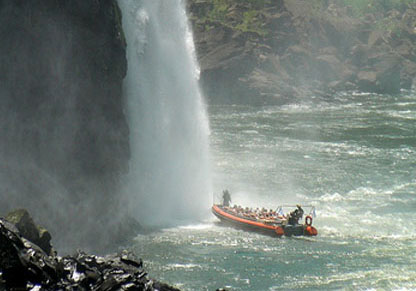By Ada M. Alvarez
IGUAZU, Argentina —You need a poncho when you go to Iguazu Falls. At the Falls, one of the great natural wonders of the world, a fine mist sprays over the jumble of cataracts, the walkways and the lookout points. The views here, at the northeast border of Argentina with Brazil, are mesmerizing. Butterflies pirouette in the wet air and families of rainbows spring up and fade in the shifting light.
The falls, discovered by the Spanish explorer Alvar Nuñez Cabeza de Vaca in 1541, are breathtaking. But they lost some of their luster this year as a drought gripped northeastern Argentina and southern Brazil. Eventually, the rains came and replenished the Iguazu and Parana Rivers that feed the Falls. And Iguazu was back to its old glory. But the dry spell of several months underscored the fragility of the environment and how much is at stake as evidence of climate change builds around the world.
The United Nations, governments and corporations are concerned. A worldwide meeting on climate change is being held in Copenhagen in December and water, vital for human survival and revered for its aesthetic virtues, will be prominent on the agenda. “It is clear that urgent action is needed if we are to avoid a global water crisis,” the United Nations said in a report this year from its World Water Assessment Program.
Local water shortages are multiplying around the world. Australia has suffered a decade-long drought. Brazil and South Africa, which depend on hydroelectric power, have suffered repeated brownouts because water shortages have reduced the flows that drive the turbines that produce the electricity.
The last two decades were the hottest for the environment in hundreds of years, according to the National Science Foundation. Scientists at the Scripps Institution of Oceanography say they expect water supplies from glaciers and snow reserves to dwindle as the polar icecap melts. “In a warmer world,” said Dr. Tim Barnett of the Scripps Institute in a statement, “there is less snowfall. The snow melts earlier, there is less rain.”
Climate simulations by the National Aeronautics and Space Administration demonstrate that as global temperatures rise, water vapor takes longer to coalesce and fall from the sky as rain, snow and hail. The World Health Organization estimates that 4 billion people could be facing severe water shortages in 40 years if current trends continue.
The solution, scientists say, is to break the trend, stop damaging the environment in hopes of reversing the process. Many harmful practices, like spewing automobile exhaust fumes, chopping down rainforests and depleting underground water sources or aquifers, can be addressed immediately.
At Iguazu, which has been a national park in Argentina since 1934, the staff and officials have a long tradition of conservation. A formal conservation plan was developed nine years ago and the museum of ecological awareness opened then. But the staff and officials at Iguazu Falls were powerless when the rain refused to come this year. They could only watch as the Falls shriveled.
The Falls of Iguazu ramble over 2.5 miles in Argentina and Brazil. At Iguazu, which means “big water” in Guaraní the native Indian language, the water splashes over 275 separate rock formations. The most impressive of the Falls is called the Devil’s Throat. It is U-shaped, 82 meters or 89.6 yards high, 150 meters wide and 700 meters long. It marks the border between Argentina and Brazil.
Two-thirds of the Falls are in Argentina. About a million people visit the Falls every year on the Argentine side and the money they spent is important to Argentina. Twenty-five years ago the United Nations declared the Falls a part of the natural patrimony of the world.
For three months this year, starting in February, water was flowing through Iguazu Falls at just 25 percent of the historic rate – about 20 million gallons a second, down from 88 million gallons a second. A drought cut back the waters of Iguazu Falls three years ago, but that episode was not nearly as severe.
It finally began raining at Iguazu in early May. “I’m so glad it rained” said Margarita Mielnichuk, one of several biologists hired as guides at Iguazu. Ms. Mielnichuk said the lack of rain had been “definitely a problem.” There had been occasional rain in the first months of the year. But total rainfall was about half the historic average.
Thick forests form a border around Iguazu Falls and the open stretch of rushing, spraying water sometimes takes on the look of a huge natural amphitheater. When the Falls are thriving, the roar of the water racing over sheer cliffs and crashing on outcroppings of rock is the music of Iguazu.
When the water became scarce this year the melody changed. The chirp and twitter of birds filled the air. The songs of the birds were pleasant. But they were also an unsettling reminder that the Falls had lost their force – and their voice. Now the Falls are roaring again. But it is hard not to worry that at some point, once again, the song of the birds may become the song of Iguazu Falls. #

